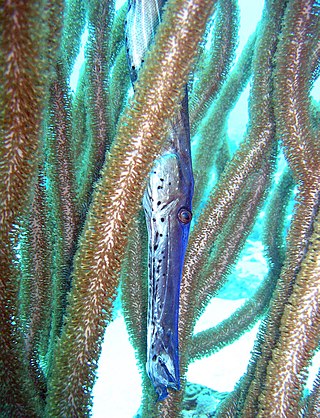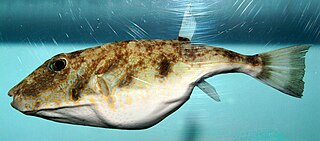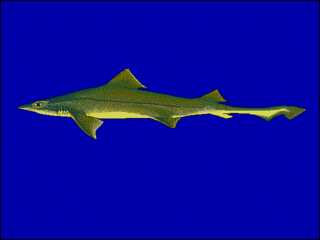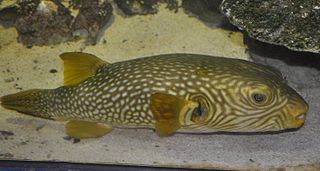
Tetraodontidae is a family of primarily marine and estuarine fish of the order Tetraodontiformes. The family includes many familiar species variously called pufferfish, puffers, balloonfish, blowfish, blowers, blowies, bubblefish, globefish, swellfish, toadfish, toadies, toadle, honey toads, sugar toads, and sea squab. They are morphologically similar to the closely related porcupinefish, which have large external spines.

Aulostomus maculatus, the West Atlantic trumpetfish, is a long-bodied fish with an upturned mouth. It often swims vertically while trying to blend with vertical coral, such as sea rods, sea pens, and pipe sponges.

The narrow-lined pufferfish is a demersal marine fish belonging to the family Tetraodontidae.

The marbled parrotfish, also known as the seagrass parrotfish, is a species of marine ray-finned fish, a parrotfish from the family Scaridae and is the only known member of the genus Leptoscarus. It has a wide Indo-Pacific distribution and is also found in the southeastern Atlantic Ocean. It is a coastal species found in beds of sea grass and seaweed.

Sphoeroides is a genus of pufferfishes.

The speckled smooth-hound is a houndshark of the family Triakidae. It is found on the continental shelf of the eastern Pacific, between latitudes 0° and 54° S, at depths between 16 and 50 m. It can reach a length of 130 cm (51 in). Collectively with certain other species of shark, it is known as "tollo".

The inshore lizardfish is a member of the family Synodontidae found in the western Atlantic.

The bandtail puffer is a species in the family Tetraodontidae, or pufferfishes. It can grow to a length of about 30 cm and is common in the Caribbean and observed from Massachusetts, USA in the north to Santa Catarina, Brazil in the south.

Least puffer is a species in the family Tetraodontidae, or pufferfishes. This species is the common bay and inshore puffer for the waters around Texas and Louisiana. It has also been found as far east as Apalachicola Bay and south to Yucatán. Mature least puffers are small, usually less than four inches (100 mm).

The northern puffer, Sphoeroides spheroides, is a species in the family Tetraodontidae, or pufferfishes, found along the Atlantic coast of North America. Unlike many other pufferfish species, the flesh of the northern puffer is not poisonous, although its viscera can contain poison, and high concentrations of toxins have been observed in the skin of Floridian populations. They are commonly called sugar toads in the Chesapeake Bay region, where they are eaten as a delicacy. There was widespread consumption of northern puffers during the rationing that accompanied the Second World War, establishing a commercial fishery that reached its zenith in the 1960s. In much of the Northeast, the fish is known simply as "blowfish" or "chicken of the sea". They may also be sold as "sea squab".

Platy is a common name of freshwater fish in the genus Xiphophorus that lack a "sword" at the bottom of their tails. Both species are livebearers, similar to other fish of the family Poeciliidae, such as the guppy and molly. Platies are native to the east coast of Central America and southern Mexico.

Sphoeroides annulatus is a species in the family Tetraodontidae, or pufferfishes. It is found in the eastern Pacific Ocean from California, USA to Pisco, Peru and the Galápagos Islands.

The warty prowfish, also known as the smooth prowfish or Tasmanian prowfish, is a species of marine ray-finned fish, an Australian prowfish belonging to the family Pataecidae, It is endemic to the coastal waters of southern Australia where it inhabits mostly rocky reefs. This species is the only member of the monotypic genus Aetapcus.

Platycephalus laevigatus, the rock flathead, black flathead, grass flathead, king flathead, marbled-bellied flathead, Port Albert flathead, smooth flathead or Southern rock flathead, is a species of marine ray-finned fish belonging to the family Platycephalidae, the flatheads. This species is endemic to Australia.

The eyed flounder is a species of fish in the family Bothidae. The species is found on or near the sandy seabed in relatively shallow waters in the western Atlantic Ocean, the Caribbean Sea and the Gulf of Mexico.

Monacanthus ciliatus, commonly known as the fringed filefish, the cuckold or the leather-fish, is a species of bony fish commonly found in shallow water in the western Atlantic Ocean, the Caribbean Sea and the Gulf of Mexico.

Arothron reticularis, variously known as the reticulated pufferfish, reticulated blowfish or reticulated toadfish, is a ray-finned fish in the family Tetraodontidae. It is native to the tropical and sub-tropical Indo-Pacific region where its habitats include sandy and muddy seabeds, coral reefs, estuaries and mangrove areas.

Pelates quadrilineatus, also known as the trumpeter perch or fourlined terapon, is a species of ray-finned fish in the family Terapontidae, the grunters. It occurs in the western Indo-Pacific region, and also in the eastern Mediterranean Sea, having arrived there by passing through the Suez Canal.

Lophogobius cyprinoides, commonly known as the crested goby, is a small fish that is widespread throughout the western Atlantic Ocean.

Sphoeroides camila is a species of pufferfish native to the Brazil. Previously thought to be the bandtail puffer (Sphoeroides spengleri), the species was discovered through DNA analysis. The fish lives in the western Atlantic from northern to southeastern Brazil, and some may be found in the southern Caribbean.





















